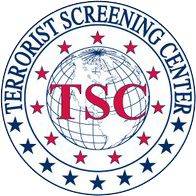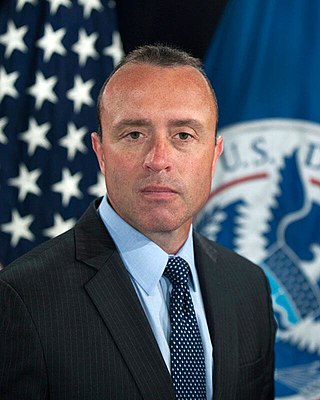Related Research Articles

The National Communications System (NCS) was an office within the United States Department of Homeland Security charged with enabling national security and emergency preparedness communications using the national telecommunications system. The NCS was disbanded by Executive Order 13618 on July 6, 2012.
Homeland security is an American national security term for "the national effort to ensure a homeland that is safe, secure, and resilient against terrorism and other hazards where American interests, aspirations, and ways of life can thrive" to the "national effort to prevent terrorist attacks within the United States, reduce the vulnerability of the U.S. to terrorism, and minimize the damage from attacks that do occur." According to an official work published by the Congressional Research Service in 2013, the "Homeland security" term's definition has varied over time.

The United States Department of Homeland Security (DHS) is the U.S. federal executive department responsible for public security, roughly comparable to the interior or home ministries of other countries. Its stated missions involve anti-terrorism, border security, immigration and customs, cyber security, and disaster prevention and management.

InfraGard is a national non-profit organization serving as a public-private partnership between U.S. businesses and the Federal Bureau of Investigation. The organization is an information sharing and analysis effort serving the interests, and combining the knowledge base of, a wide range of private sector and government members. InfraGard is an association of individuals that facilitates information sharing and intelligence between businesses, academic institutions, state and local law enforcement agencies, and other participants dedicated to preventing hostile acts against the United States.

The Federal Protective Service (FPS) is a federal law enforcement agency of the United States Department of Homeland Security (DHS). It is also "the federal agency charged with protecting and delivering integrated law enforcement and security services to facilities owned or leased by the General Services Administration (GSA)"—over 9,000 buildings—and their occupants.

The National Cyber Security Division (NCSD) is a division of the Office of Cyber Security & Communications, within the United States Department of Homeland Security's Cybersecurity and Infrastructure Security Agency. Formed from the Critical Infrastructure Assurance Office, the National Infrastructure Protection Center, the Federal Computer Incident Response Center, and the National Communications System, NCSD opened on June 6, 2003. The NCSD mission is to collaborate with the private sector, government, military, and intelligence stakeholders to conduct risk assessments and mitigate vulnerabilities and threats to information technology assets and activities affecting the operation of the civilian government and private sector critical cyber infrastructures. NCSD also provides cyber threat and vulnerability analysis, early warning, and incident response assistance for public and private sector constituents. NCSD carries out the majority of DHS’ responsibilities under the Comprehensive National Cybersecurity Initiative. The FY 2011 budget request for NCSD is $378.744 million and includes 342 federal positions. The current director of the NCSD is John Streufert, former chief information security officer (CISO) for the United States Department of State, who assumed the position in January 2012.

The Homeland Security Act (HSA) of 2002, was introduced in the aftermath of the September 11 attacks and subsequent mailings of anthrax spores. The HSA was cosponsored by 118 members of Congress. The act passed the U.S. Senate by a vote of 90–9, with one Senator not voting. It was signed into law by President George W. Bush in November 2002.

The National Crime Information Center (NCIC) is the United States' central database for tracking crime-related information. The NCIC has been an information sharing tool since 1967. It is maintained by the Criminal Justice Information Services Division (CJIS) of the Federal Bureau of Investigation (FBI) and is interlinked with federal, tribal, state, and local agencies and offices.
The National Infrastructure Protection Plan (NIPP) is a document called for by Homeland Security Presidential Directive 7, which aims to unify Critical Infrastructure and Key Resource (CIKR) protection efforts across the country. The latest version of the plan was produced in 2013 The NIPP's goals are to protect critical infrastructure and key resources and ensure resiliency. It is generally considered unwieldy and not an actual plan to be carried out in an emergency, but it is useful as a mechanism for developing coordination between government and the private sector. The NIPP is based on the model laid out in the 1998 Presidential Decision Directive-63, which identified critical sectors of the economy and tasked relevant government agencies to work with them on sharing information and on strengthening responses to attack.

In the U.S., critical infrastructure protection (CIP) is a concept that relates to the preparedness and response to serious incidents that involve the critical infrastructure of a region or the nation. The American Presidential directive PDD-63 of May 1998 set up a national program of "Critical Infrastructure Protection". In 2014 the NIST Cybersecurity Framework was published after further presidential directives.

The Terrorist Screening Database (TSDB) is the central terrorist watchlist consolidated by the Federal Bureau of Investigation's Terrorist Screening Center and used by multiple agencies to compile their specific watchlists and for screening. The list was created after the September 11 attacks.

The Office of Intelligence and Analysis (I&A) is the civilian national intelligence component of the United States Department of Homeland Security and one of two statutory members of the United States Intelligence Community (IC) within DHS, the other being Coast Guard Intelligence. It is the only member of the IC tasked with providing intelligence to State, Local, Tribal and Territorial (SLTT) governments, and private sector entities, and developing national intelligence products from information collected by SLTT entities.
The Criminal, Cyber, Response, and Services Branch (CCRSB) is a service within the Federal Bureau of Investigation (FBI). The CCRSB is responsible for investigating financial crime, white-collar crime, violent crime, organized crime, public corruption, violations of individual civil rights, and drug-related crime. In addition, the Branch also oversees all computer-based crime related to counterterrorism, counterintelligence, and criminal threats against the United States.
Todd A. Levett was an American homeland security and foreign affairs advisor, public servant, and strategist based in Washington, DC. He died of brain cancer on October 30, 2014.

The National Cybersecurity and Critical Infrastructure Protection Act of 2013 is a bill that would amend the Homeland Security Act of 2002 to require the Secretary of the Department of Homeland Security (DHS) to conduct cybersecurity activities on behalf of the federal government and would codify the role of DHS in preventing and responding to cybersecurity incidents involving the Information Technology (IT) systems of federal civilian agencies and critical infrastructure in the United States.

David J. Glawe was the Under Secretary of Homeland Security for Intelligence and Analysis from January 2017 to May 2020 and is currently the President and CEO of the National Insurance Crime Bureau.
The National Cybersecurity and Communications Integration Center (NCCIC) is part of the Cybersecurity Division of the Cybersecurity and Infrastructure Security Agency, an agency of the U.S. Department of Homeland Security. It acts to coordinate various aspects of the U.S. federal government's cybersecurity and cyberattack mitigation efforts through cooperation with civilian agencies, infrastructure operators, state and local governments, and international partners.
Dr. Phyllis Schneck is an American executive and cybersecurity professional. As of May 2017, she became the managing director at Promontory Financial Group. Schneck served in the Obama administration as Deputy Under Secretary for Cybersecurity and Communications for the National Protection and Programs Directorate (NPPD), at the Department of Homeland Security.

The Cybersecurity and Infrastructure Security Agency (CISA) is a component of the United States Department of Homeland Security (DHS) responsible for cybersecurity and infrastructure protection across all levels of government, coordinating cybersecurity programs with U.S. states, and improving the government's cybersecurity protections against private and nation-state hackers.
References
- 1 2 Gale Encyclopedia of Espionage & Intelligence. Infrastructure Protection Center (NIPC), United States National
- ↑ United States Information Service Washington File. Retrieved 2013-02-08.
- ↑ FBI. FBI and the National Infrastructure Protection Center Publicly Introduce the National InfraGard Program.
- ↑ About the InfraGard Archived 2011-05-18 at the Wayback Machine
- ↑ Free Encyclopedia of Ecommerce. National Infrastructure Protection Center (NIPC).
- ↑ National Infrastructure Protection Center. www.nipc.gov (archived)